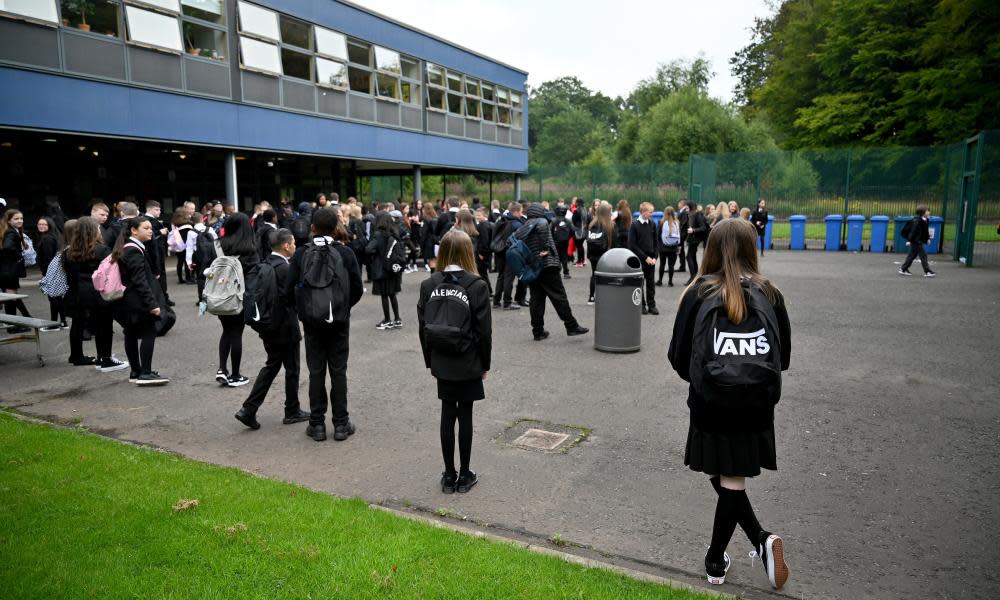Scottish secondary school pupils set to wear face masks in corridors

Secondary school pupils in Scotland are expected to be told soon that they must wear face coverings in school corridors and communal areas after health fears escalated following a series of overcrowding incidents.
Nicola Sturgeon, the Scottish first minister, said her deputy, John Swinney, was consulting councils and teaching organisations about the measure after they were recommended for secondary schools by the World Health Organization at the weekend.
WHO said face coverings were useful where physical distancing between adults and pupils aged 12 and over was impossible, or in areas of high transmission.
Sturgeon said the measures, which would include staff, would cover corridors and communal areas where overcrowding was a risk factor; busy corridors were noisier, which meant people were more likely to shout, increasing the risk of aerosol transmission of the virus, and were also less easily ventilated.
She said her government, which had previously said face coverings were unnecessary in schools, was also considering ways of ensuring that teachers had sufficient supplies of free disposable masks in case children arrived without them.
Several high schools in Scotland have already implemented the measures, including James Gillespie’s in Edinburgh, Grantown grammar school in Grantown-on-Spey and Millburn academy in Inverness, after experiencing overcrowding in corridors and communal areas.
The move, which follows growing pressure from teachers’ unions and opposition parties, came as health officials in Tayside disclosed that 17 teachers at a special school in Dundee had contracted Covid-19, along with two pupils and three community contacts.
NHS Tayside shut Kingspark school last Wednesday for deep cleaning after the outbreak emerged, and on Friday closed it to allow staff and pupils to self-isolate for 14 days because of the pupils’ complex needs.
The board said on Sunday 22 people were infected, up from 12 on Friday. It said contact tracing had identified links to two other schools in Dundee, with one positive case at St Peter’s and St Paul’s primary, and another at Happy Times out-of school club at Downfield primary.
All the pupils in the affected class at St Peter’s and St Paul’s have been asked to stay at home and self-isolate.
In a further outbreak, two primary school classes at High Blantyre primary school in Lanarkshire have been told to stay at home after a teacher and two pupils tested positive over the weekend.
default
Dr Ellie Hothersall, a consultant in public health medicine with NHS Tayside, said: “Since the identification of positive cases at Kingspark, a detailed contact-tracing programme has been under way and these linked cases are being identified because of those concerted efforts of test and protect.
“We must do everything we can to protect all of our communities against Covid-19 and that is why we have issued the guidance to self-isolate. By taking this action we are containing any further spread of infection.
“We know that this may cause anxiety to some parents and children but we must do everything we can to ensure we keep people safe.”
The outbreaks are the latest in a series either at or linked to Scottish schools since classes resumed earlier in August, in some cases leading to entire classes being told to remain at home and self-isolate. Those cases involved schools in Glasgow, Perth, Blairgowrie, Paisley, Johnstone and Coatbridge.
After weeks of falls, Scotland’s Covid-19 infection rate is climbing again, with two large outbreaks involving pub-goers in Aberdeen and chicken factory workers in Coupar Angus, also in the NHS Tayside region.
There were 83 new cases detected across Scotland on Sunday and 123 on Saturday – the highest daily figure since mid-May. In July, the number of new cases was regularly as low as between one and four a day. There have been no new deaths of confirmed Covid-19 patients since Wednesday.
Larry Flanagan, the general secretary of the EIS, Scotland’s largest teachers’ union, said the face-covering measures were welcome, but said it still believed the most effective mitigation measures were smaller classes and greater physical distancing.
“The EIS continues to believe that effective physical distancing is the best means of reducing the risk of Covid-19 spread in schools,” he said. “We are continuing to press the Scottish government for more staff and smaller classes to achieve this.”
Sturgeon said a decision was likely to be announced in the next few days.

 Yahoo News
Yahoo News 
